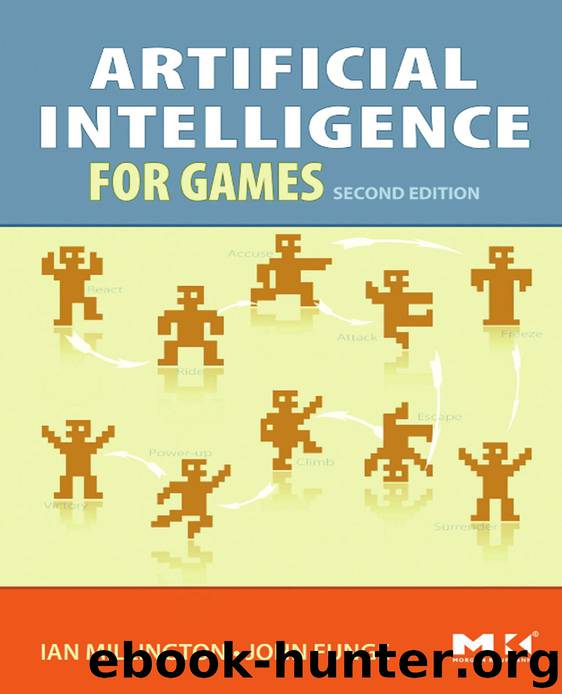Artificial Intelligence for Games by Ian Millington & John Funge

Author:Ian Millington & John Funge [Millington, Ian & Funge, John]
Language: eng
Format: epub, mobi
Tags: Art, Digital, Computers, Desktop Applications, Design & Graphics
ISBN: 9780123747310
Google: 1OJ8EhvuPXAC
Amazon: 0123747317
Publisher: CRC Press
Published: 2009-08-06T04:00:00+00:00
454 Chapter 5 Decision Making
ing ?person-1))
ver
y ?person-1))
adio (held-b
(r
(?person-1 (health <15)) (?person-2 (health >45))
(?person-2 (is-co
Bindings:
Bindings:
None
A
?person-2 = Captain
Bindings:
Bindings:
Bindings:
(?person-1 = Johnson,
?person-1 = Whisker
None
?person-2 = Captain) OR
(?person-1 = Sale,
?person-2 = Whisker)
B
C
Bindings:
Bindings:
None
None
Swap Radio rule
Change Backup rule
Figure 5.51
Rete in mid-update
On the Website
The pseudo-code of Rete is many pages long and doesn’t make the algorithm any clearer for its
complexity. We decided not to include it here and waste several pages with difficult-to-follow
code. A full source code implementation is provided on the website, with lots of comments, that
we’d recommend you work through.
Library
The Rule-Based System program on the website allows you to play with a simple rule-based
system and database. It is a command line program that allows you to add facts to the database
using the simple LISP syntax shown above.You can run a rule set against it to see how matches are
processed. The Rete can be viewed at any time, and the program gives lots of feedback on which
nodes in the Rete are being processed and the variable bindings they are passing on.
Program
Performance
Rete approaches O( nmp) in time, where n is the number of rules, m is the number of clauses per rule, and p is the number of facts in the database. If a large number of wild card matches is
possible, then the process of unifying the bindings in the join node can take over the performance.
In most practical systems, however, this isn’t a major issue.
5.8 Rule-Based Systems
455
ing ?person-1))
ver
y ?person-1))
adio (held-b
(r
(?person-1 (health <15)) (?person-2 (health >45))
(?person-2 (is-co
Bindings:
Bindings:
?person-1 = Sale
A
?person-2 = Whisker OR
?person-2 = Captain
Bindings:
Bindings:
Bindings:
(?person-1 = Johnson,
?person-1 = Whisker
None
?person-2 = Captain) OR
(?person-1 = Sale,
?person-2 = Whisker)
B
C
Bindings:
(?person-1 = Sale,
Bindings:
?person-2 = Whisker) OR
Bindings:
None
(?person-1 = Sale,
?person-1 = Sale
?person-2 = Captain)
?person-2 = Whisker
Swap Radio rule
Change Backup rule
Figure 5.52
Rete after-update
Rete is O( nmq) in memory, where q is the number of different wild-card matches per pattern.
This is significantly higher than the basic rule matching system we developed first. In addition, in
order to take advantage of the fast update, we need to keep the data between iterations. It is this
high memory usage that gives the speed advantage.
5.8.9 Extensions
The ubiquity of rule-based systems in early AI research led to a whole host of different extensions,
modifications, and optimizations. Each area in which a rule-based system was applied (such as
language understanding, controlling industrial processes, diagnosing faults in machinery, and
many others) has its own set of common tricks.
Very few of these are directly usable in games development. Given that rule-based systems are
only needed in a minority of AI scenarios, we’ll safely ignore most of them here. We’d recommend
Expert Systems: Principles and Programming [Giarratano and Riley, 1998], for more background
on industrial uses. It comes with a copy of CLIPS, a reasonably general expert system shell.
There are two extensions that are widespread enough to be worth mentioning. The first man-
ages huge rule-based systems and is of direct use to games developers. The second is justification,
widely used in expert systems and useful to game developers when debugging their AI code.
456 Chapter 5 Decision Making
We could fill an entire book on algorithms for rule-based systems. Given their niche status in
game development, we will limit this section to a brief overview of each extension.
Download
Artificial Intelligence for Games by Ian Millington & John Funge.mobi
This site does not store any files on its server. We only index and link to content provided by other sites. Please contact the content providers to delete copyright contents if any and email us, we'll remove relevant links or contents immediately.
Kathy Andrews Collection by Kathy Andrews(10519)
Thirteen Reasons Why by Jay Asher(7788)
The Red Files by Lee Winter(2914)
How to Do Nothing by Jenny Odell(2645)
The Genius of Japanese Carpentry by Azby Brown(2609)
Stacked Decks by The Rotenberg Collection(2270)
Tattoo Art by Doralba Picerno(2083)
Champions of Illusion by Susana Martinez-Conde & Stephen Macknik(2075)
The Art of Doom by Bethesda(1774)
The Artist's Way Workbook by Cameron Julia(1724)
Calligraphy For Dummies by Jim Bennett(1643)
Creative Character Design by Bryan Tillman(1557)
Botanical Line Drawing by Peggy Dean(1529)
One Drawing A Day by Veronica Lawlor(1494)
Wall and Piece by Banksy(1458)
The Art of Creative Watercolor by Danielle Donaldson(1451)
Art Of Atari by Tim Lapetino(1325)
Happy Hand Lettering by Jen Wagner(1322)
Artificial Intelligence for Games by Ian Millington & John Funge(1301)
